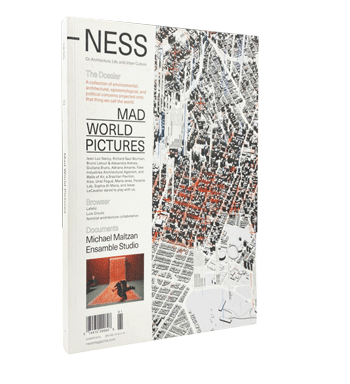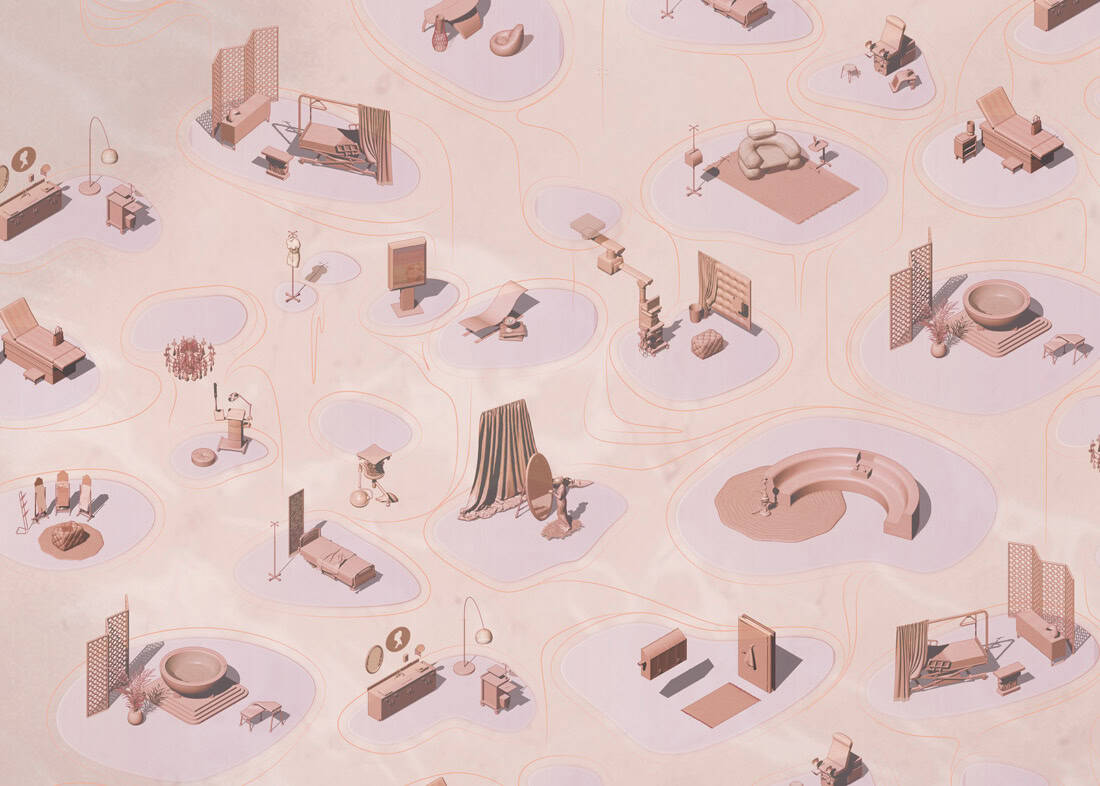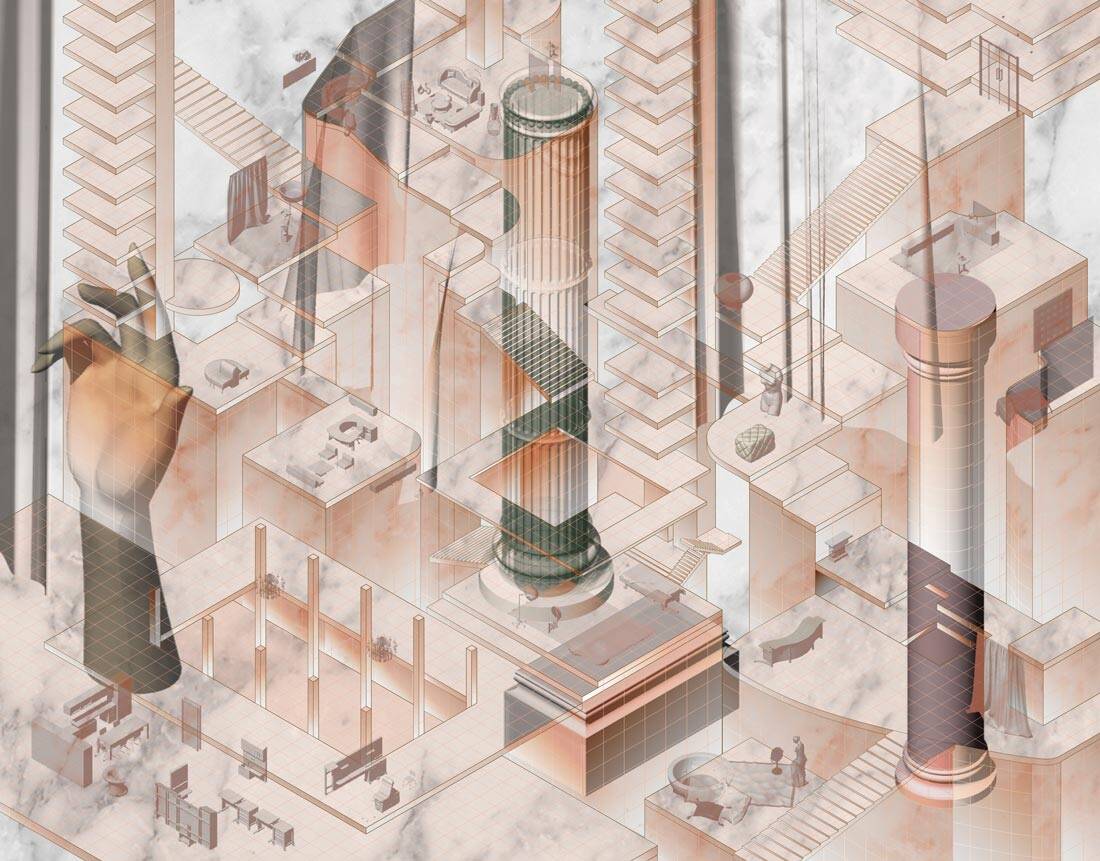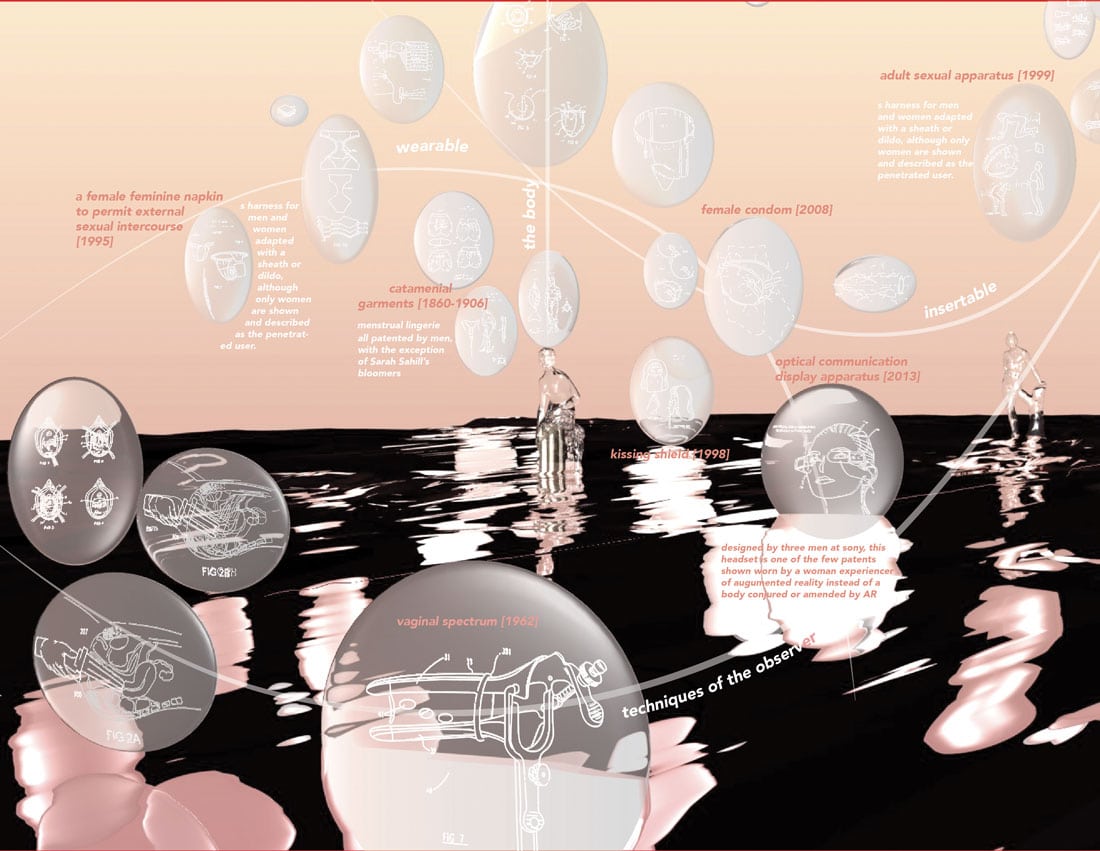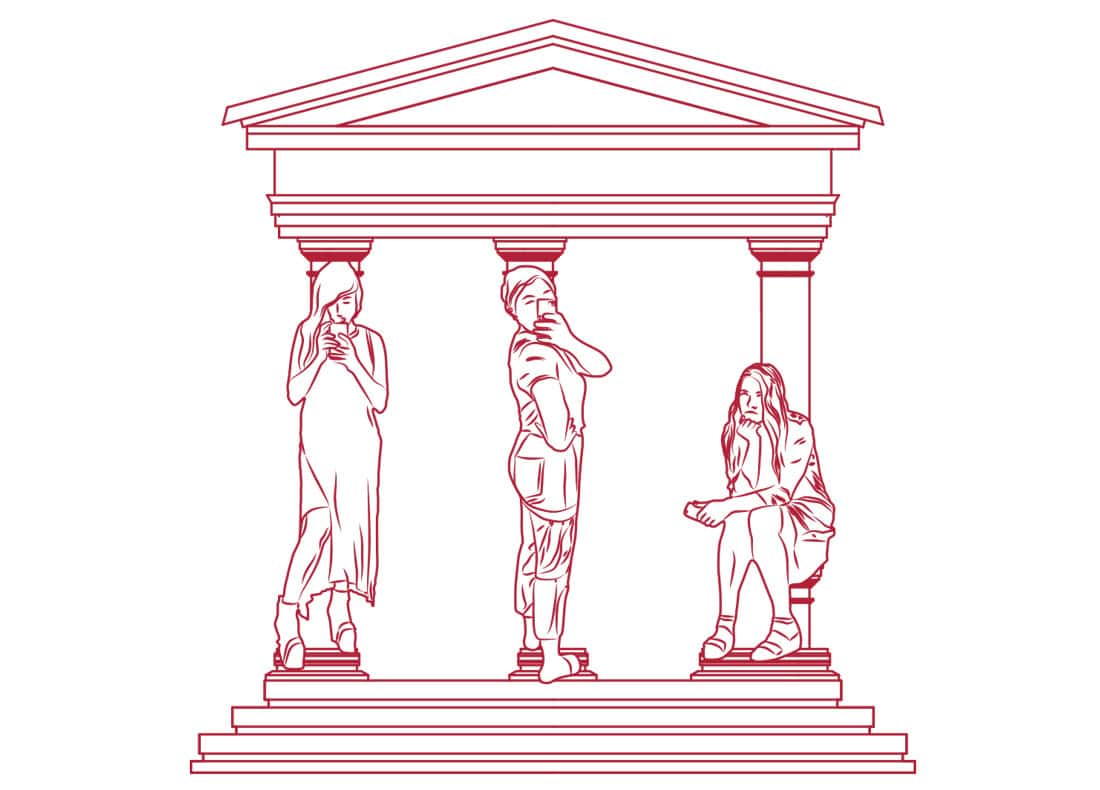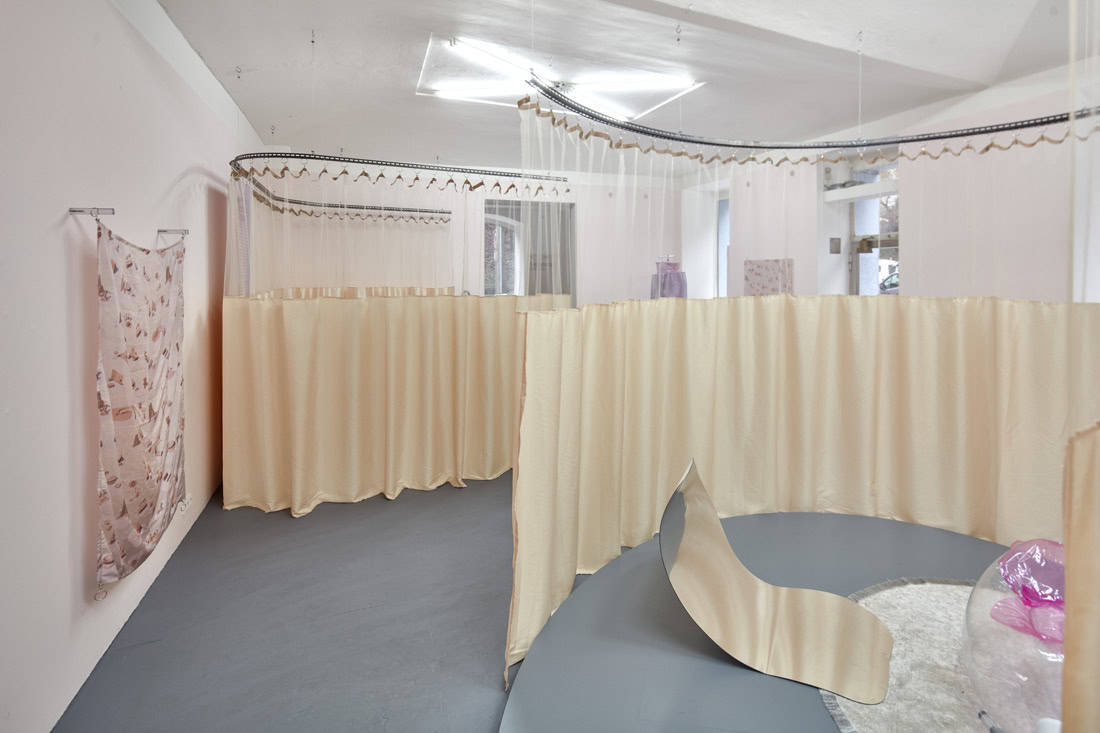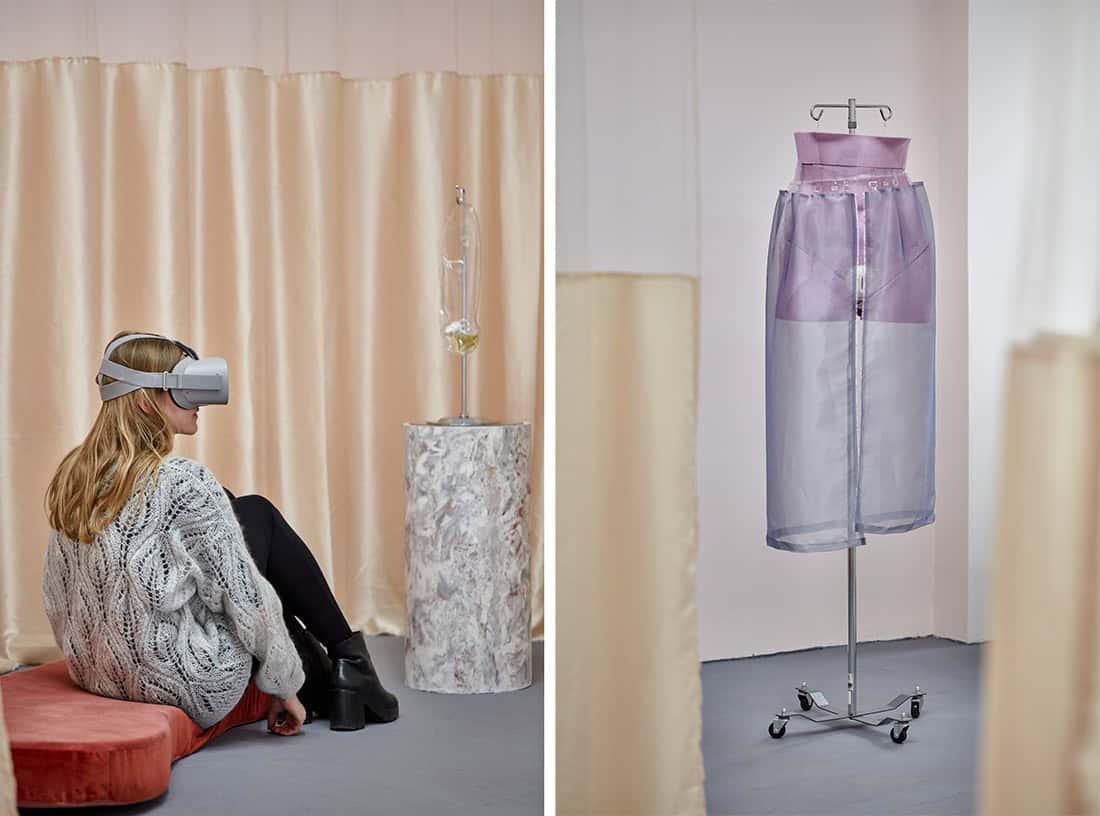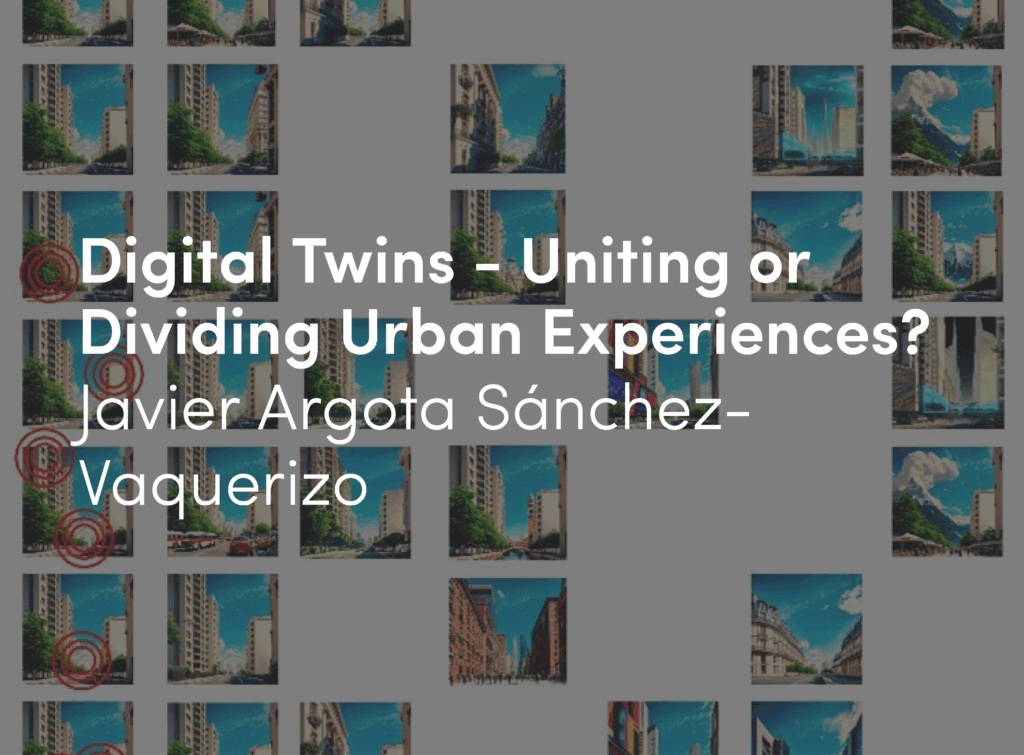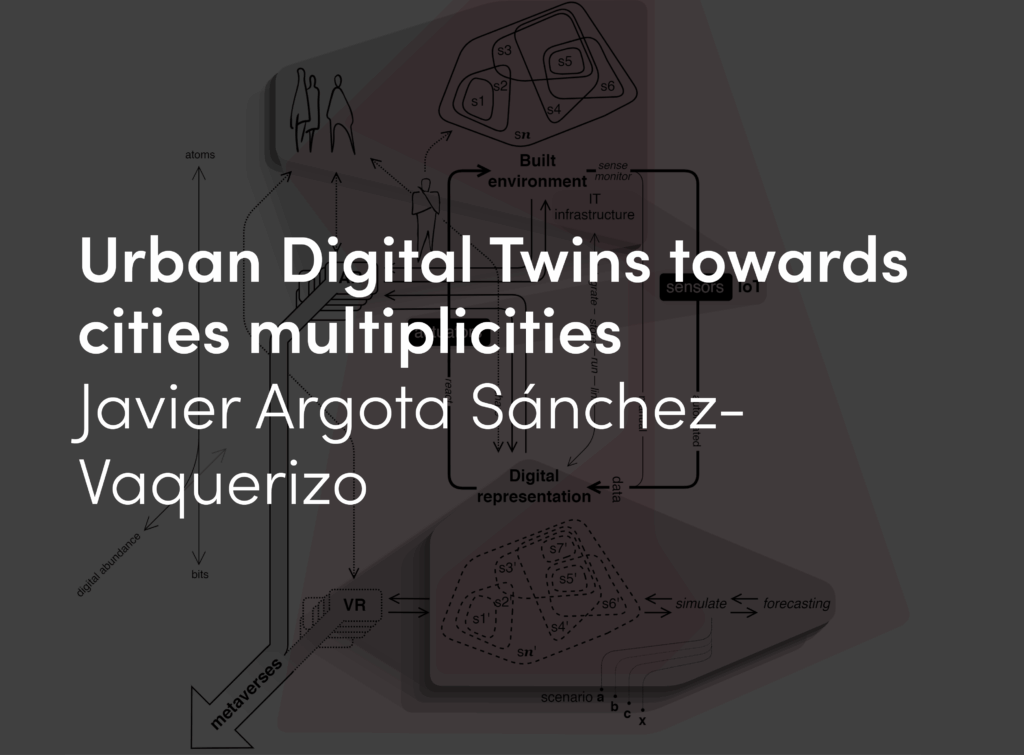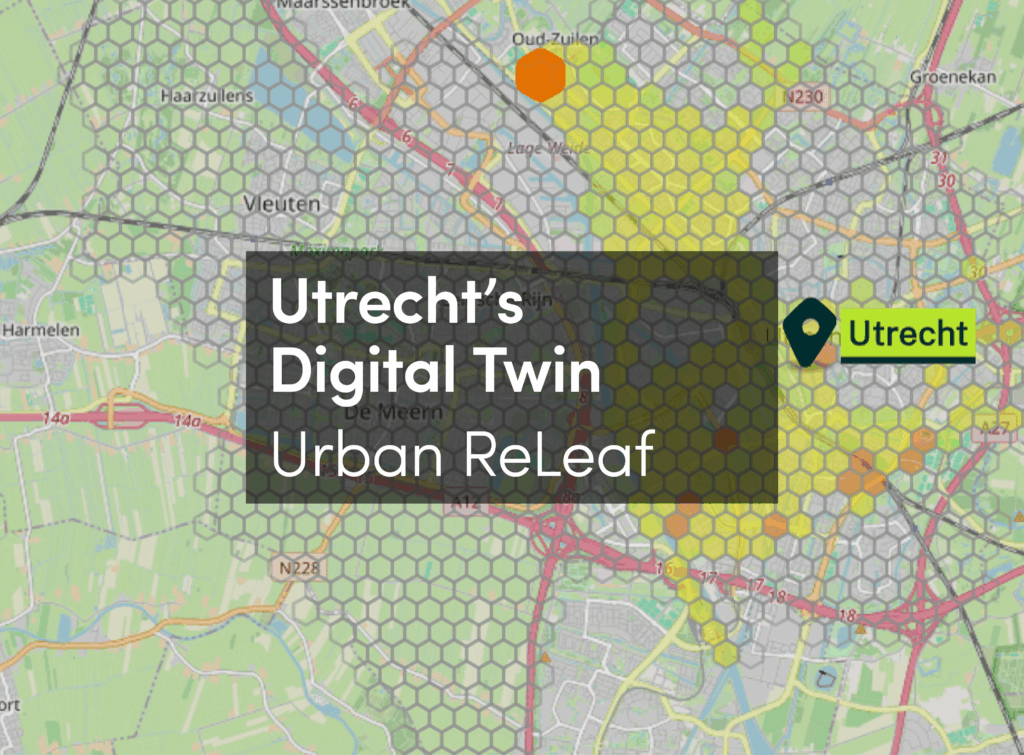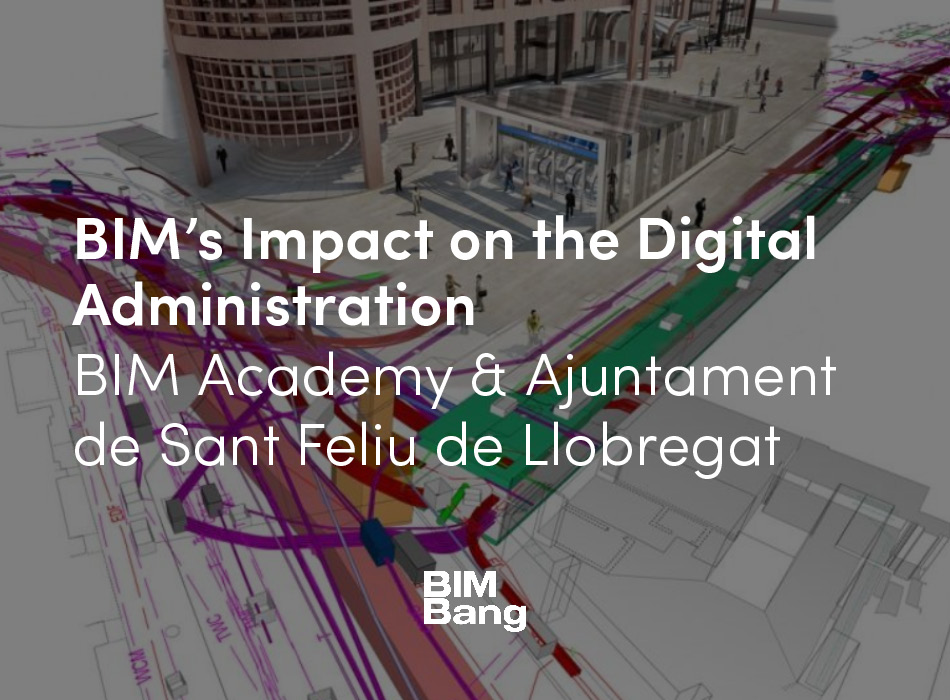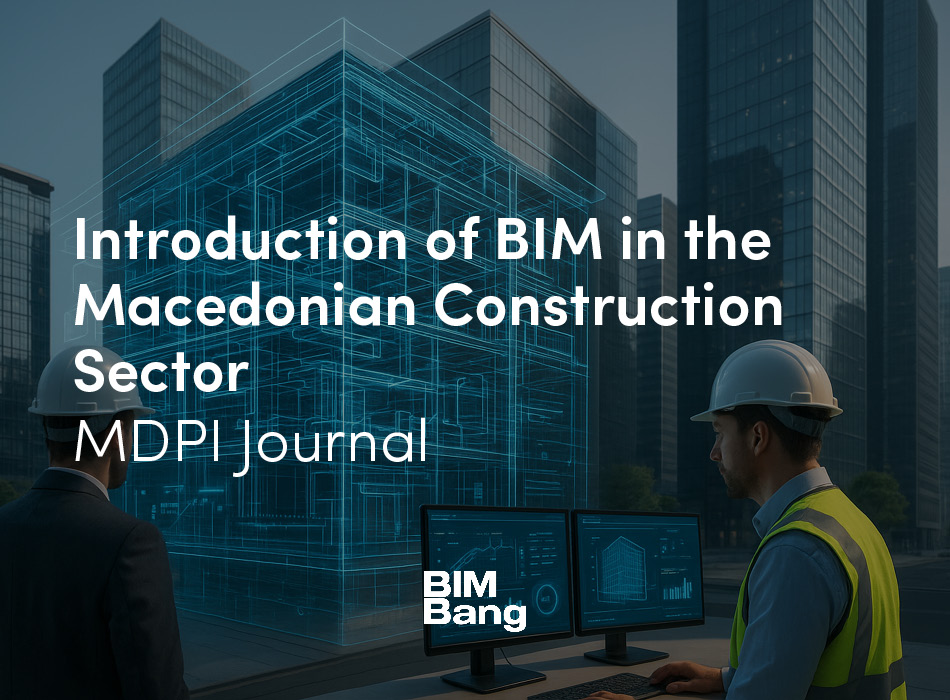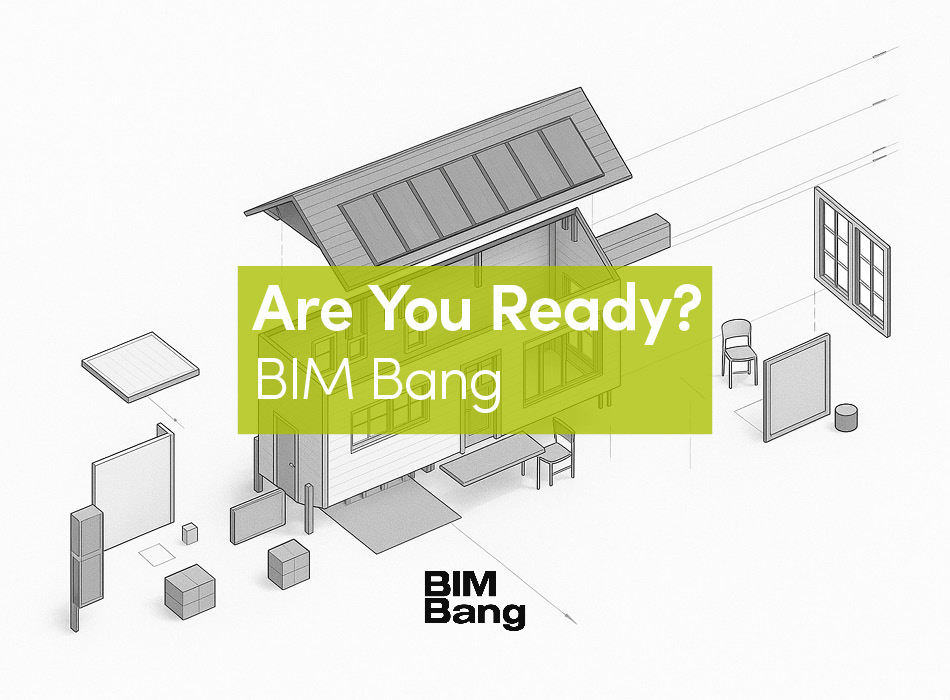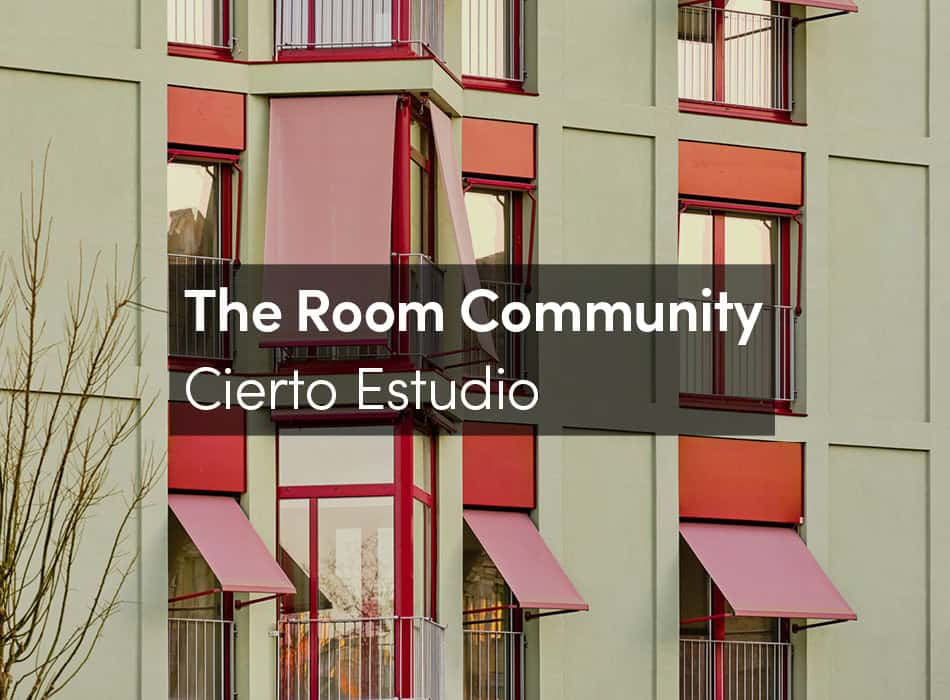When I met Gabrielle Printz, Virginia Black, and Rosana Elkhatib, we were sharing the same shiny working space at NEW INC, Trump had been recently elected, and along with other graduates from Columbia University GSAPP, they were incubating the “Post-Fordist Hymen Factory” project and hosting political architectural conclaves surrounded by popcorn, light beer, sodas, and music. Since then, feminist architecture collaborative has multiplied their projects and collaborations around the world, tackling the relationship between bodies, spatial politics, intimacy, and intercontinental work structures. I met with them again to discuss further their current strategies and thoughts. Below is our conversation on disentangling dominant discourses, work privilege, and advocating for other ways of being.
Proposal for “Cosmo-Clinical Interiors of Beirut.” Courtesy of f-arch.
AGUSTIN SCHANG
I am interested in knowing more about the beginning of your collaboration. I know you met at Columbia GSAPP doing the Critical, Curatorial, and Conceptual Practices in Architecture master’s program. How did your friendship and that educational environment prompt the creation of your project? [They gazed into each other’s eyes, back and forth, Virginia to Rosana, Rosana to Gabby, Gabby to Virginia. Lattes spilled around them. Drake played softly from a phone. The Google Drive organized autonomously into folders labelled: hymens, mamas, words, fun.] How did you decide to call your project feminist architecture collaborative? And besides your specific practice, how do you envision, and what are your thoughts on, the role of feminism in the current architectural field?
F-ARCHITECTURE
Do you mean fuck-architecture? We wanted to name a thing that didn’t appear to exist, the office we wanted to work for. feminist architecture collaborative isn’t a project (because that would assume its separability from our lives, so entangled). It’s a firm, a shared alias, an attitude, an aspiration to power, a way for us to be and work together under whatever circumstances. But ideally, we also design those circumstances.
Proposal for “Cosmo-Clinical Interiors of Beirut.” Courtesy of f-arch.
AS
Collaboration has a significant presence in your work, from your own partnership to the association with other independent groups, enterprises, or institutions through different projects. How do you decide who to partner with? How do you navigate the most classical institutional world of architecture?
F-ARCH
Everyone wants to feminist-architecture with us, but proper collaboration takes time and resources. It’s not just an ‘x’ between some upstart creative and some more resourced brand. We seek out alliances that result in a productive exchange of ideas and values, ones where we are not only advocating for someone or something, but producing something of some value, critical or practical.
AS
In a recent interview, you mentioned slow making and exploring process as a protest in itself. Could you elaborate more on this? How much of your practice is based on the reaction or the necessity of protesting against current political and social issues?
F-ARCH
I think we are interested in the logistics and tools of protest, which are often not all that reactionary, but which take time and persistence and organizing. I assure you, we are not holed up in a studio carefully iterating plaster models. Rather, our work consists in laboring over a ‘problem’ that might not need a solution, but more information, study, critique, conversation, or representation, and forms of action in and between and from research. Architecture is political. It works on people and their lives, and there is no separating political power and will from the space in which it’s framed, or the processes by which the built world is financed, formed, and imposed upon its non/human occupants, and certainly not from the structural forms of oppression called patriarchy and white supremacy. So, a thread of resistance to those circumstances where architecture is made (not to build, to call bullshit, to make another claim) weaves through our process and in work that, generally, might fit under the banner ‘intervention.’
Conceptual map of “Post-Fordist Hymen Factory.” Courtesy of f-arch.
AS
What is your approach to research as an activist spatial practice? What are the particularities of a feminist strategy to critical spatial practice? Who are your influencers in this field?
F-ARCH
The particularities of feminist practice rarely get to come to the fore, as one is constantly required to justify or qualify one’s practice as feminist. We are getting tired, but embracing the term feminist requires constantly eschewing the stereotypes associated with the term, even in academia: “Will you ever collaborate with men?” is a question we’ve been asked on multiple occasions like, “do you imagine men are part of the audience for this project?” Which is to say that the content named ‘women’s issues’ precludes them. We ain’t gonna sit here and say we’re not interested in content under the term ‘woman’ (I mean, we 3D-printed a hymen after all), but the way that work must proceed is a much stickier question, and like, who cares if we collaborate with men or not? Thank you, next. Your question necessarily involves defending our position in the field, against its dominant discourses, the structures that privilege certain work over other ‘theoretical,’ ‘speculative,’ or purely ‘political’ work. The methodology is itself invested in disentangling structures of power, but we are always forced to address our own position in that web, in which we are not real architects, not real researchers, maybe artists or activists. But not advocates, some suppose, because the work is more slippery, more argumentative than true advocacy. #feminism—one grounded in the pursuit of equity, in recognition of privilege, in a discursive framework that includes many voices, if we gotta define it for you—is at work in our writing,[1] the way we conduct our research, have conversations with collaborators, treat interns, care for each other, compensate labor, draw, specify finishes, sign emails, take up space, refuse to smile, perform for an audience, hiss at our detractors, embrace critique. Theory and practice, it’s a swirl.
Here is a list of people you can @ on Twitter so they know we stand with them: @feministkilljoy, @AyeshaASiddiqi, @theorygurl
Your research and exploration of public forms and contexts is connected with projects situated all around the world: from the Middle East to Latin America to New York. How do you adapt your discourse to these different locations and circumstances?
F-ARCH
The discourse emerges from a sensitivity to these sites, not western feminism made suitable for its touching down in Amman or Quito or wherever. It is informed by the specificity of an issue like virginity in the frame of honor culture, or like, the precise meaning of cultivating manioc in the chagra, or going to the capital to presence parteras. We have to engage directly with people at work in these places, in a way that negotiates between the urgency of a political situation and the desires, dreams, and ideals that might inform other ways of being.
“Cosmo-Clinical Interiors of Beirut.” Courtesy of f-arch.
AS
In November 2018 you opened an exhibition in Prague about clinics in Beirut as sites of bodily reinvention and production. How did this project come together from the research to the display itself?
F-ARCH
The exhibition was an opportunity to absorb and reproduce some of the strange object-forms we had encountered in our research on the global virginity market and in the clinic environments we visited in Beirut—specifically those offering hymenoplastic procedures. The interior finishes, appealing to a hi-femme sensibility, and which hint at a luxury surgical experience, are remade into a curtained, clinic-like environment in the gallery, where we occasion other potential forms of bodily production or representation (via the critical hymen object) and listen to the voices of women who have had experiences with the procedure (via our soundscape in clinic VR). Here the pressure on the body and its proper form is deferred to the interior architecture of the clinic lobby, the recovery suite, the examination room.
“Cosmo-Clinical Interiors of Beirut.” Courtesy of f-arch.
AS
How do you envision feminist architecture collaborative in the next ten years? Do you think it could turn into a larger collaborative network of feminist practitioners?
F-ARCH
No. We have big dreams, but those are just for us to hold close to our hearts for now. We hope that a network of feminist practitioners comes into being, and that we are part of it, but we don’t see it as our mandate to forge the structure for that coming together.





